Ruins Of Xunantunich – Mayan City That Once Flourished
A. Sutherland - AncientPages.com - Xunantunich, a major ceremonial center of the Maya Civilization, is an ancient Maya archaeological site atop a ridge above the Mopan River, about 80 miles (130 km) west of Belize City, Cayo District, in western Belize.
"El Castillo" at Xunantunich. Photo credits: Denis Barthel - CC BY-SA 4.0
It comprises six major plazas, surrounded by over twenty-five temples and palaces.
The name 'Xunantunich' derives from the Yucatec Maya language and means 'Stone Woman' (or "Lady of the Rock"). It is a modern name; its ancient name is currently unknown.
Local legend holds that around the end of the 1800s, a man from the village of San Jose Succotz went hunting near the site and suddenly saw a beautiful statuesque Maya maiden standing motionless in the rays of the rising sun near the mouth of a cave, which extended beneath the giant structure.
Stricken by her appearance, the man threw his gun aside and ran downhill to the village. After recounting his tale, several villagers led by the native priest returned to the site.
Arriving at the large mound, they found the mouth of the tunnel, but the stone maiden had disappeared. After that, locals claim that the woman has appeared to several others, but none have been able to follow her into the cavern.
Xunantunich was first explored in the 1800s by Dr. Thomas Gann, a British medical officer who later returned to the ancient place. As records state, he unearthed many Maya treasures, the history of which have been lost and the whereabouts unknown.
The place was occupied perhaps as early as 300 B.C., but most of the Maya architecture there was developed in the late classic period. Later, the inhabitants of Xunantunich continually built new temples and residences over older buildings, enlarging the ceremonial center by raising the platforms and structures in the process.
Xunantunich has a very representative structure known as The Castle (El Castillo), which is the second tallest pre-Columbian building in Belize after the Temple of El Caracol, reaching a height of 40 meters from; it offers from the top an impressive view of the jungle canopy, the other ruins, and even beyond the border.
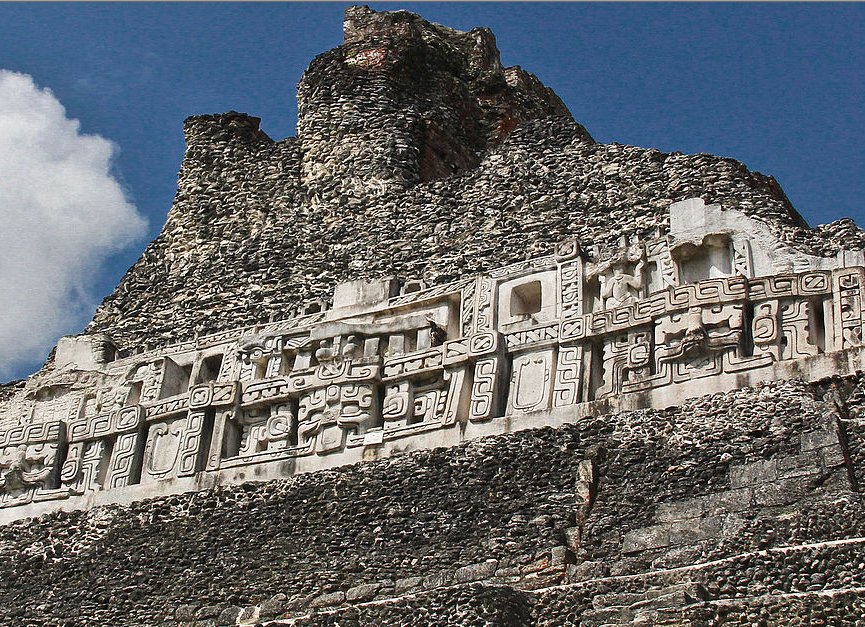 Carvings on the peak of the El Castillo pyramid (Structure A6) at Xunantunich, Belize. Image credit: cjuneau - CC BY 2.0
Carvings on the peak of the El Castillo pyramid (Structure A6) at Xunantunich, Belize. Image credit: cjuneau - CC BY 2.0
The site's name comes from the Yucatec Maya for Stone Woman and is a modern name, like those given to many other archaeological sites in Mesoamerica. Old names still need to be discovered. According to Belizeans, the stone woman refers to a ghost that lives in the archaeological zone. The ghost is all black, and his eyes are lit like fire.
The figure usually appears before the Castle and then ascends the stone steps to disappear into the stone wall. After Xunantunich ceased being a famous ceremonial and civic center, some people continued to occupy its area or perhaps reoccupied it. The excavations of Xunantunich have confirmed that the Maya people lived in the Belize region for centuries.
Later, extensive archaeological work was done in Xunantunich, now an impressive, well-excavated, and easily accessible Mayan site.
Xunantunich was a thriving Mayan city during the Classic Period. The hills were first occupied between 400 BC and 200 BC, and it was in 600 AD that Xunantunich was first used as a ceremonial site, making the entire site some 1400 years old. The site has an ancient ball court where intense pok ta pok ball games were organized, and the loser of the game faced sudden death.
However, the Maya warriors often lost their heads regardless of whether they won. Not far from Xunantunich, there is a mysterious cave that was important for Mayan rituals and human sacrifice.
Interestingly, during a time when most of the Mayan civilizations were crumbling, Xunantunich was managing to expand its city and its power over other areas within the valley. Around 1000 AD, however, Xunantunich was abandoned.
Written by – A. Sutherland - AncientPages.com Senior Staff Writer
Updated on January 14, 2024
Copyright © AncientPages.com All rights reserved. This material may not be published, broadcast, rewritten or redistributed in whole or part without the express written permission of AncientPages.com
Expand for referencesMore From Ancient Pages
-
 Mysterious 9,000-Year-Old Shaman Burial In Bad Dürrenberg – One Of Central Europe’s Most Spectacular Archaeological Discoveries
Featured Stories | Sep 15, 2023
Mysterious 9,000-Year-Old Shaman Burial In Bad Dürrenberg – One Of Central Europe’s Most Spectacular Archaeological Discoveries
Featured Stories | Sep 15, 2023 -
 12 Ancient Egyptian Symbols Explained
Ancient Symbols | May 9, 2017
12 Ancient Egyptian Symbols Explained
Ancient Symbols | May 9, 2017 -
 Suprising Evolution Discovery – Human Temporal Lobes Are Not Very Large In Comparison With Other Primates
Archaeology | Mar 21, 2023
Suprising Evolution Discovery – Human Temporal Lobes Are Not Very Large In Comparison With Other Primates
Archaeology | Mar 21, 2023 -
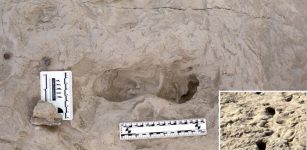 1.5-Million-Year-Old Footprints Of Two Different Species Of Human Ancestors Found At The Same Spot
Human Beginnings | Nov 29, 2024
1.5-Million-Year-Old Footprints Of Two Different Species Of Human Ancestors Found At The Same Spot
Human Beginnings | Nov 29, 2024 -
 Face Of Very Old “Vampire” Buried In Connecticut Reconstructed
Archaeology | Nov 9, 2022
Face Of Very Old “Vampire” Buried In Connecticut Reconstructed
Archaeology | Nov 9, 2022 -
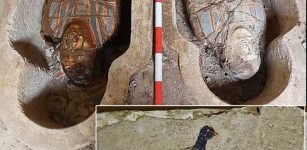 Intriguing Ptolemaic And Roman Treasures Unearthed In Al Bahnasa, Egypt
Archaeology | Jan 10, 2024
Intriguing Ptolemaic And Roman Treasures Unearthed In Al Bahnasa, Egypt
Archaeology | Jan 10, 2024 -
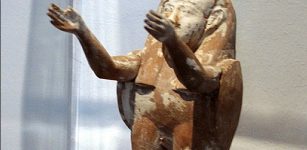 Ancient Beliefs About The Soul
Civilizations | Mar 8, 2016
Ancient Beliefs About The Soul
Civilizations | Mar 8, 2016 -
 Chalchihuitlicue: Beautiful, Dangerous, Changeable And Unpredictable Water Goddess In Aztec Mythology
Featured Stories | Mar 20, 2024
Chalchihuitlicue: Beautiful, Dangerous, Changeable And Unpredictable Water Goddess In Aztec Mythology
Featured Stories | Mar 20, 2024 -
 Why Did Students Turn Medieval Oxford Into A Murder Capital?
Places | Sep 28, 2023
Why Did Students Turn Medieval Oxford Into A Murder Capital?
Places | Sep 28, 2023 -
 3,000-Year-Old Geoglyphs May Depict The Heavens
Archaeology | Jun 25, 2018
3,000-Year-Old Geoglyphs May Depict The Heavens
Archaeology | Jun 25, 2018 -
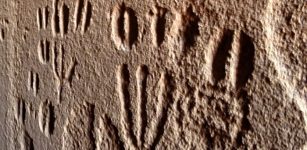 Animal Tracks And Human Footprints In Prehistoric Hunter-Gatherer Rock Art In Namibia
Archaeology | Sep 13, 2023
Animal Tracks And Human Footprints In Prehistoric Hunter-Gatherer Rock Art In Namibia
Archaeology | Sep 13, 2023 -
 Puzzling Ancient Artifacts Of Unknown Origin And Purpose
Artifacts | Mar 10, 2014
Puzzling Ancient Artifacts Of Unknown Origin And Purpose
Artifacts | Mar 10, 2014 -
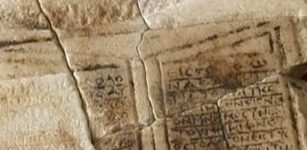 Last Fragment Of Early Christian Christogram Found In Ancient City Of Parthicopolis, Bulgaria
Artifacts | Sep 9, 2015
Last Fragment Of Early Christian Christogram Found In Ancient City Of Parthicopolis, Bulgaria
Artifacts | Sep 9, 2015 -
 Mysterious Artifacts Scattered Around Mount Baigong, China
News | Jun 23, 2014
Mysterious Artifacts Scattered Around Mount Baigong, China
News | Jun 23, 2014 -
 Pytheas’s Voyage To The Arctic In 325 B.C. And Account Of Thule, The Strange Land Beyond
Featured Stories | May 29, 2021
Pytheas’s Voyage To The Arctic In 325 B.C. And Account Of Thule, The Strange Land Beyond
Featured Stories | May 29, 2021 -
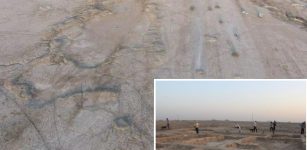 Large 4,000-Year-Old Sumerian Port Discovered In The Desert In Iraq
Archaeology | Apr 4, 2018
Large 4,000-Year-Old Sumerian Port Discovered In The Desert In Iraq
Archaeology | Apr 4, 2018 -
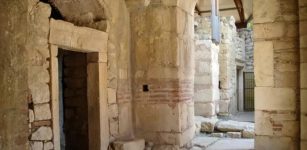 Has The Tomb Of The Real Santa Claus Been Found In Turkey?
News | Oct 5, 2017
Has The Tomb Of The Real Santa Claus Been Found In Turkey?
News | Oct 5, 2017 -
 Gnomes – Fantastic Supernatural Creatures Knowing Secrets Of Earth Mountains Rivers And Rocks
Myths & Legends | Nov 20, 2018
Gnomes – Fantastic Supernatural Creatures Knowing Secrets Of Earth Mountains Rivers And Rocks
Myths & Legends | Nov 20, 2018 -
 Why Do Some Men Think Often About The Roman Empire?
News | Oct 4, 2023
Why Do Some Men Think Often About The Roman Empire?
News | Oct 4, 2023 -
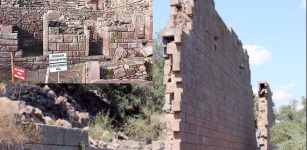 Headteacher’s Sarcophagus Unearthed In Ancient City Of Aigai, Turkey
Archaeology | Jan 25, 2017
Headteacher’s Sarcophagus Unearthed In Ancient City Of Aigai, Turkey
Archaeology | Jan 25, 2017

